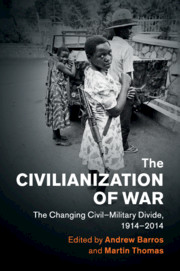Refine search
Actions for selected content:
15418 results in Military history
12 - Turn Everyone into a Civilian: René Cassin and the UNESCO Project, 1919–1945
- from Part III - Civilian Protection and International Norms and Organizations: When and How Much?
-
-
- Book:
- The Civilianization of War
- Published online:
- 20 July 2018
- Print publication:
- 09 August 2018, pp 243-259
-
- Chapter
- Export citation
11 - The CIA’s Drone War and the Civilianization of Warfare
- from Part II - A Moving Target: Strategic Bombing and Civilians, 1916–2014
-
-
- Book:
- The Civilianization of War
- Published online:
- 20 July 2018
- Print publication:
- 09 August 2018, pp 221-240
-
- Chapter
- Export citation
2 - Fighting the Fifth Column: The Terror in Republican Madrid during the Spanish Civil War
- from Part Ia - The ‘Total War’ Era, 1914–1945
-
-
- Book:
- The Civilianization of War
- Published online:
- 20 July 2018
- Print publication:
- 09 August 2018, pp 47-63
-
- Chapter
- Export citation
6 - East Pakistan/Bangladesh 1971–1972: How Many Victims, Who, and Why?
- from Part Ib - The Cold War and Decolonization, 1945–2000
-
-
- Book:
- The Civilianization of War
- Published online:
- 20 July 2018
- Print publication:
- 09 August 2018, pp 116-140
-
- Chapter
- Export citation
Copyright page
-
- Book:
- The Civilianization of War
- Published online:
- 20 July 2018
- Print publication:
- 09 August 2018, pp iv-iv
-
- Chapter
- Export citation
Part III - Civilian Protection and International Norms and Organizations: When and How Much?
-
- Book:
- The Civilianization of War
- Published online:
- 20 July 2018
- Print publication:
- 09 August 2018, pp 241-319
-
- Chapter
- Export citation
3 - Moscow 1941: The Rise and Fall of the Soviet People’s Militia (Narodnoe Opolchenie)
- from Part Ia - The ‘Total War’ Era, 1914–1945
-
-
- Book:
- The Civilianization of War
- Published online:
- 20 July 2018
- Print publication:
- 09 August 2018, pp 64-80
-
- Chapter
- Export citation
Acknowledgements
-
- Book:
- The Civilianization of War
- Published online:
- 20 July 2018
- Print publication:
- 09 August 2018, pp x-x
-
- Chapter
- Export citation
Part II - A Moving Target: Strategic Bombing and Civilians, 1916–2014
-
- Book:
- The Civilianization of War
- Published online:
- 20 July 2018
- Print publication:
- 09 August 2018, pp 163-240
-
- Chapter
- Export citation
Index
-
- Book:
- The Civilianization of War
- Published online:
- 20 July 2018
- Print publication:
- 09 August 2018, pp 320-334
-
- Chapter
- Export citation
1 - Doing the Necessary: The Declaration of London and British Strategy, 1905–1915
- from Part Ia - The ‘Total War’ Era, 1914–1945
-
-
- Book:
- The Civilianization of War
- Published online:
- 20 July 2018
- Print publication:
- 09 August 2018, pp 23-46
-
- Chapter
- Export citation
Contents
-
- Book:
- The Civilianization of War
- Published online:
- 20 July 2018
- Print publication:
- 09 August 2018, pp v-vii
-
- Chapter
- Export citation
9 - Bombing Civilians Scientifically: Operational Research in Bomber Command, 1941–1945*
- from Part II - A Moving Target: Strategic Bombing and Civilians, 1916–2014
-
-
- Book:
- The Civilianization of War
- Published online:
- 20 July 2018
- Print publication:
- 09 August 2018, pp 181-195
-
- Chapter
- Export citation
8 - The Problems of Opening Pandora’s Box: Strategic Bombing and the Civil–Military Divide, 1916–1939
- from Part II - A Moving Target: Strategic Bombing and Civilians, 1916–2014
-
-
- Book:
- The Civilianization of War
- Published online:
- 20 July 2018
- Print publication:
- 09 August 2018, pp 165-180
-
- Chapter
- Export citation
Introduction: The Civilianization of War and the Changing Civil–Military Divide, 1914–2014
-
-
- Book:
- The Civilianization of War
- Published online:
- 20 July 2018
- Print publication:
- 09 August 2018, pp 1-20
-
- Chapter
-
- You have access
- HTML
- Export citation
5 - Parallel Ambiguities: Prisoners during the Algerian War of Independence
- from Part Ib - The Cold War and Decolonization, 1945–2000
-
-
- Book:
- The Civilianization of War
- Published online:
- 20 July 2018
- Print publication:
- 09 August 2018, pp 100-115
-
- Chapter
- Export citation
Part Ib - The Cold War and Decolonization, 1945–2000
- from Part I - Who Fights? Combatants, Mobilization and the Changing Nature of War
-
- Book:
- The Civilianization of War
- Published online:
- 20 July 2018
- Print publication:
- 09 August 2018, pp 81-81
-
- Chapter
- Export citation
Tables
-
- Book:
- The Civilianization of War
- Published online:
- 20 July 2018
- Print publication:
- 09 August 2018, pp viii-viii
-
- Chapter
- Export citation
7 - ‘I Wasn’t a Boy, I Was a Soldier’: Militarization and Civilianization in Narratives of Child Soldiers in Africa’s Contemporary Conflicts, c.1990–2010
- from Part Ib - The Cold War and Decolonization, 1945–2000
-
-
- Book:
- The Civilianization of War
- Published online:
- 20 July 2018
- Print publication:
- 09 August 2018, pp 141-162
-
- Chapter
- Export citation

The Civilianization of War
- The Changing Civil–Military Divide, 1914–2014
-
- Published online:
- 20 July 2018
- Print publication:
- 09 August 2018
